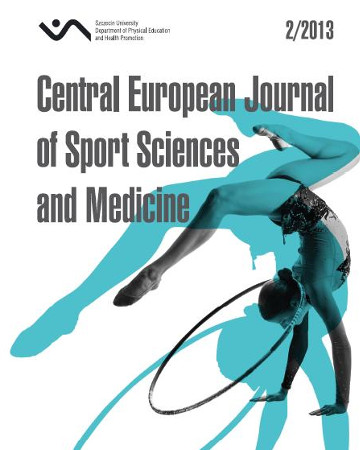
ISSN: 2300-9705
eISSN: 2353-2807
OAI




Lista wydań /
Vol. 2, No. 2/2013
The assessment of aerobic physical capacity in young swimmers
| Autorzy: |
Wioletta
Łubkowska
Department of Physical Culture and Health Promotion, University of Szczecin, Szczecin, Poland Jerzy Troszczyński Department of Physical Culture and Health Promotion, University of Szczecin, Szczecin, Poland |
| Słowa kluczowe: | aerobic capacity swimming young swimmers |
| Data publikacji całości: | 2013 |
| Liczba stron: | 9 (21-29) |
Abstrakt
The purpose of this paper was to confront some selected physiological parameters that describe aerobic capacity with young swimmers’ sports achievements. For the study, some athletes with the average age of 14.67, who train swimming at the SMS Szczecin Club, were selected. A progressive test of their oxygen power was performed in order to determine their aerobic capacity, with the means of the European Ranking (LEN). Each swimmer’s sports level was presented in points [pts.]. The swimmers’ characteristics were presented as divided into three groups: (S) – short-distance specialization, (M) – medium-distance specializati on and (L) – long-distance specialization. In group (S), maximum oxygen consumption – VO2max [l/min] achieved the levels of 3.95 [l/min] (male swimmers) and 2,77 [l/min] (female swimmers); in group (M) – 4.12 [l/min] and 2.97 [l/min], respectively; and in group (L) – 4.14 [l/min] and 3.338 [l/min]. Among male swimmers, level of VO2 max [ml/kg/min] equaled 58.96 – group (S), 59.72 – group (M) a nd 62.10 – group (L); while among female swimmers it reached 48.67 (S), 49.36 (M) and 54.60 (L), res pectively. The recorded values of VO2 max [ml/kg/min] qualify the young swimmers to the group of people with a very high physical capacity. Our selection of Szczecin’s athletes to individual groups proved to be correct. The considerations presented in the paper bring one’s attention to the substantive quality of the intake and selection of swimmers. In the selection, it is necessary to take such physiologic rates as VO2 max or VO2/HR into consideration.
Pobierz plik
Plik artykułu
Bibliografia
| 1. | Bentley D.J., Newell J., Bishop D. Incremental exercise test design and analysis: implications for performance diagnostics in endurance athletes. Sports Medicine. 2007;37(7):575-86. |
| 2. | Bishop D., Edge J. The effects of a 10-days taper on repeated–sprint performance in females. Journal of Science and Medicine in Sport. 2005;8(2):200-209. |
| 3. | EU Physical Activity Guidelines. Recommended Policy Actions In Support of Health-Enhancing Physical Activity. Fourth Consolidated Draft, Approved by the EU Working Group „Sport & Health” at its meeting, 2008. |
| 4. | Gastinger S., Sorel A., Nicolas G., Gratas-Delamarche A., Prioux J. A comparison between ventilation and heart rate as indicator of oxygen uptake during different intensities of exercise. Journal of Science and Medicine. 2010;9:110-118. |
| 5. | Jastrzębska A. Wydolność fizyczna. In: Zatoń M., Jastrzębska A. (eds). Testy fizjologiczne w ocenie wydolności fizycznej. Wydawnictwo Naukowe PWN, Warszawa 2010: 1-11, 42-75. |
| 6. | LEN (Ligue Europeenne de Natation). Ranking Europejski 2013. Queried on 6 March 2013: http://www.swimrankings.net/index.php?page=rankingDetail&club=POL. |
| 7. | Makar P., Pęczak-Graczyk A., Bielec G., Przybylski G. Zwiększenie skuteczności indywidualnej techniki pływania jako kryterium rozwoju wyników sportowych. Antropomotoryka. 2010;50:105-113. |
| 8. | Maughan R., Gleeson M., Greenhaff P.L. Biochemistry of exercise and training. Oxford University Press, Oxford 1997. |
| 9. | Montgomery J., Chambers M. Mastering swimming. Your guide for fitness, training and competition. The Masters Athlete Series. Human Kinetics Publishers 2009. |
| 10. | Obert P., Falgairette G., Bedu M., Coudert J. Bioenergetic characteristics of swimmers determined during an arm-ergometer test and during swimming. International Journal of Sports Medicine. 1992;13(4):298-303. |
| 11. | Rowland T.W. Evolution of maximal oxygen uptake in children. Medicine and Sport Science. 2007;50:200-209. |
| 12. | Siewierski M. Próba oceny efektywności kryteriów selekcyjnych w pływaniu w Szkołach Mistrzostwa Sportowego. In: Kuder A., Perkowski K. Śledziewski D. (eds). Proces doskonalenia treningu i walki sportowej. T.2, Wydawnictwo AWF Warszawa, Warszawa 2005: 54-5 |
| 13. | Sozański H., Adamczyk J., Siewierski M. Sport dzieci i młodzieży – niektóre efekty długofalowe. In: Urniaż J. (eds). Współczesne trendy rozwoju sportu a idee humanizmu olimpijskiego. Olsztyńska Szkoła Wyższa, Olsztyn 2008:59-79. |
| 14. | Wasserman K., Hauser J.E., Sue D.J., Whipp B.J. Principles of exercise testing and interpretation. Lea and Febiger, Philadelphia 1987. |
| 15. | Wojciechowska - Maszkowska B., Więcek J., Więcek A. Ocena wydolności fizycznej chłopców trenujących kajakarstwo i pływanie w oparciu o pomiar maksymalnego pochłaniania tlenu (VO2max). Annales Universitatis Mariae Curie-Skłodowska Lublin – Polonia. SECTIO |
| 16. | Zatoń M. Ocena zmian adaptacyjnych na podstawie kontroli efektów treningu. In: Zatoń M., Jastrzębska A. (eds). Testy fizjologiczne w ocenie wydolności fizycznej. Wydawnictwo Naukowe PWN, Warszawa 2010:169-175. |
| 17. | Zatoń M., Zatoń K., Kulik K. Wpływ rekreacyjnego uprawiania snowboardu na zdolność wysiłkową 16-17 – letnich chłopców. Sport Wyczynowy. 2009;4(532): 100-108. |